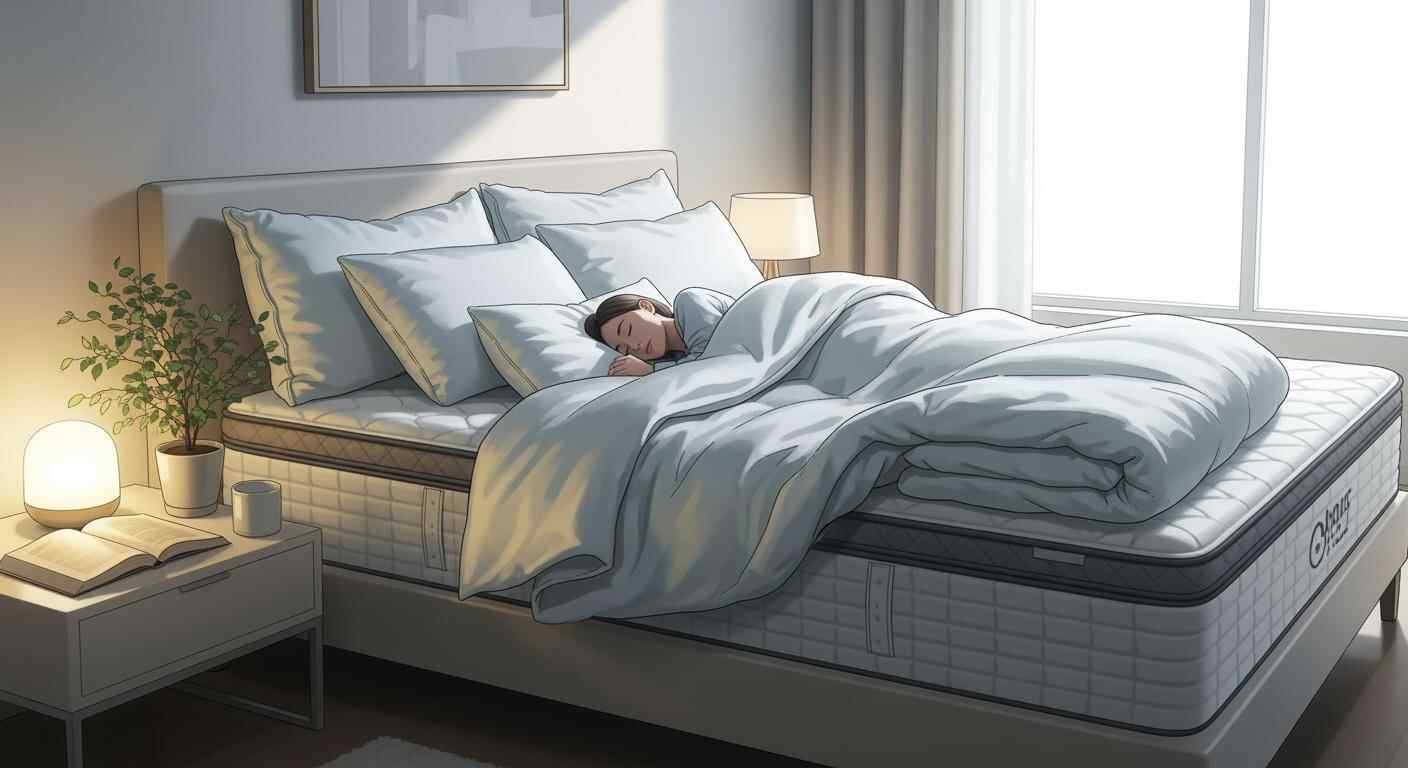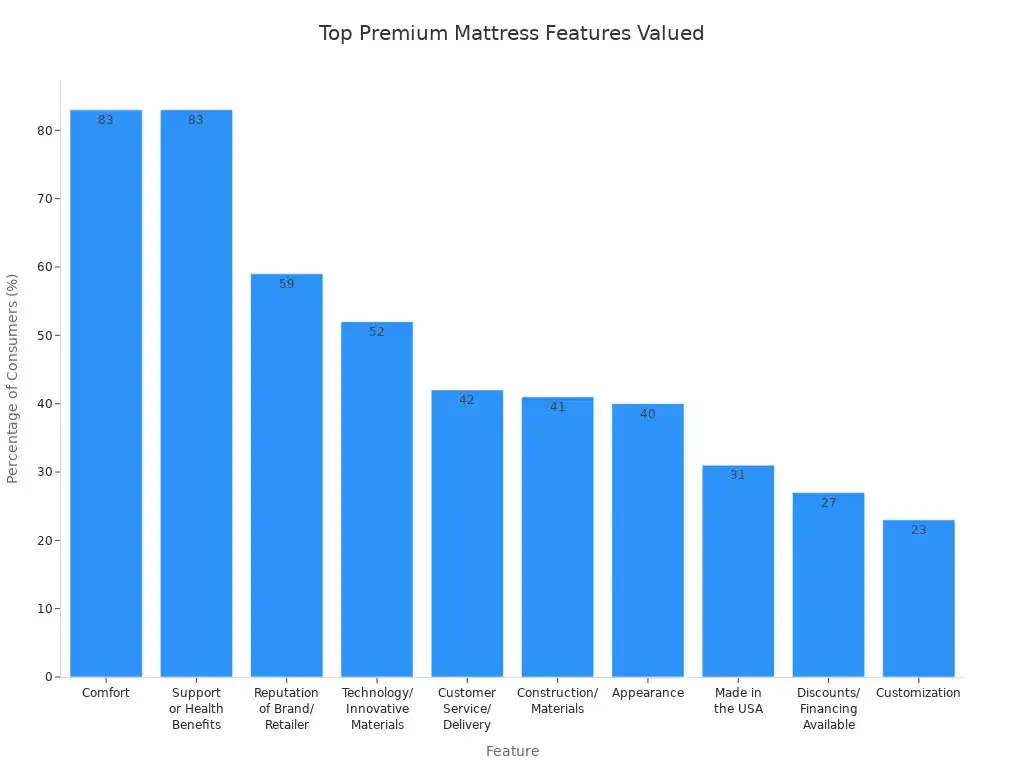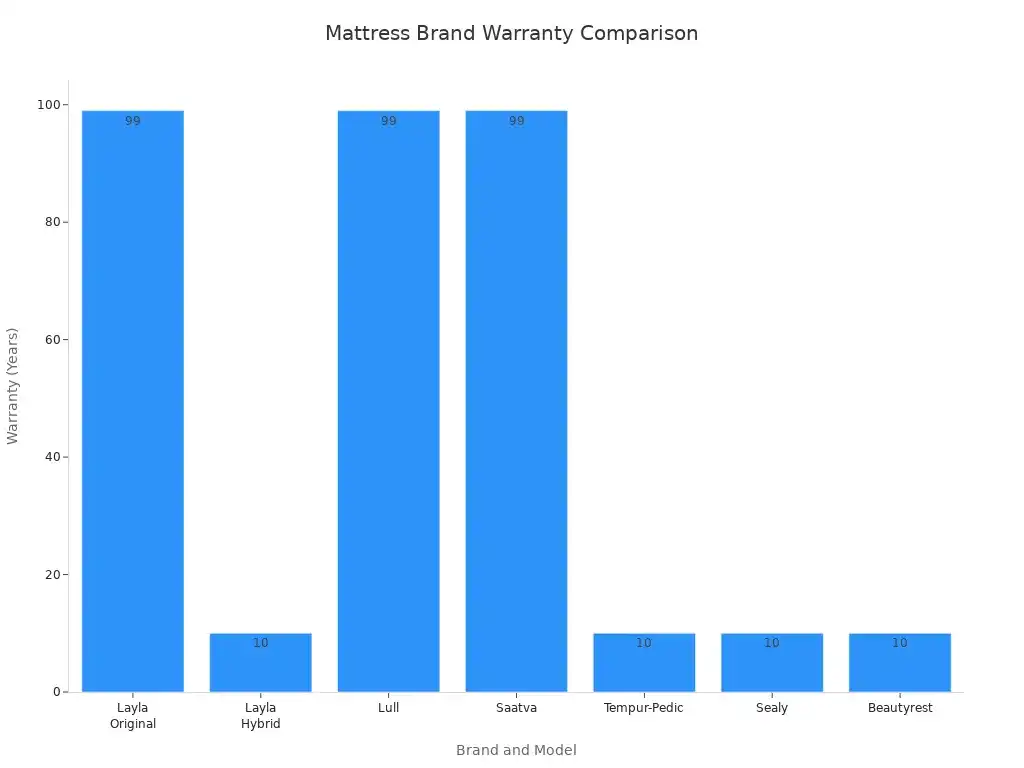Address
No.3 Chengcai Road, Leliu Town, Shunde District, Foshan City, Guangdong, China 528322
Address
No.3 Chengcai Road, Leliu Town, Shunde District, Foshan City, Guangdong, China 528322
Choose a mattress high end by matching firmness, support, and features to your sleep style, body type, and budget for optimal comfort and restful nights.


Shopping for a mattress high end can feel overwhelming. You want a new mattress that fits your body and helps you get a good night’s sleep. The best mattress depends on your comfort and support needs, your body type, and your budget. Most buyers care about a few things:
Comfort, support, and health benefits matter to 83% of people.
Brand reputation influences 59%.
Technology or innovative materials attract 52%.
You deserve a mattress that feels great and gives lasting value.
Figure out how you like to sleep. Side, back, and stomach sleepers need different mattresses. Pick a mattress that helps you sleep in your favorite way.
Think about your body type. People who weigh more often need firmer mattresses for support. People who weigh less may want softer mattresses for comfort.
Try out how firm the mattress is. Lie down in your favorite sleep position. See if the mattress feels good and gives you support.
Check for special features. Look for cooling technology, edge support, and durability. These things can make your sleep better.
Use trial periods. Most brands let you test the mattress at home for 100 to 365 nights. Try it out to make sure it works for you.
Everyone has a way they like to sleep. Some people sleep on their side. Others sleep on their back or stomach. The way you sleep changes what mattress feels best. It also changes how much support you get. Look at this table to see what you might need:
Sleep Position | Key Needs | Mattress Recommendations |
|---|---|---|
Side Sleepers | Proper spinal alignment, support at hips and shoulders, adequate cushioning | Medium to soft firmness with good contouring |
Back Sleepers | Consistent support, attention to lower back curve, stable surface | Medium firmness for balance of support and comfort |
Stomach Sleepers | Harder feel to prevent sinking, responsive surface, minimal contouring | Firm mattress to maintain neutral spine position |
Combination Sleepers | Responsive surfaces for position changes, balanced support | Versatile mattress that accommodates multiple positions |
If you sleep on your side, you need a mattress that helps your hips and shoulders. Back sleepers need a mattress that keeps their spine straight. They also need gentle support. Stomach sleepers should pick a firmer mattress. This stops them from sinking in too much. If you move around at night, you need a mattress with balanced support.
Tip: When you test mattresses, lie down in your favorite sleep position. See if you feel comfortable. Notice if any part of your body feels sore.
Your body type matters when picking a mattress. Heavier people need firmer mattresses. This keeps them from sinking too much. Lighter people often like softer beds. Softer beds have plush layers that feel nice. Here are some things to remember:
Side sleepers need softer mattresses for comfort. Back and stomach sleepers do better with firmer mattresses.
Heavier people should pick firmer mattresses. These last longer and give better support.
Lighter people get more comfort from softer mattresses. Softer mattresses cushion their body.
If you have a heavier body, choose a firmer mattress with high-density latex layers. This gives you better support.
If you have a lighter body, pick a softer mattress with plush layers. This gives you the right comfort.
A mattress high end gives you choices for your sleep style and body type. When your mattress matches your needs, you wake up feeling good and without pain.

When you shop for a mattress high end, you see many choices. Each type has its own feel, support, and lifespan. Let’s break down the main types so you can pick what fits you best.
Memory foam mattresses hug your body. You feel like you sink in a little, but the foam supports you. This type works well if you sleep on your side or want to avoid waking up when your partner moves. Memory foam gives great pressure relief and motion isolation.
Pros:
Excellent pressure relief for hips and shoulders
Good motion isolation, so you don’t feel movement
Personalized support that adapts to your shape
Cons:
Can retain heat, making you feel warm at night
Off-gassing smell when new
Heavy to move
Tip: Look for high-density memory foam in a mattress high end. Densities between 4-5 pounds per cubic foot last longer and keep their shape.
Here’s a quick look at how memory foam compares to other types:
Mattress Type | Durability | Comfort Characteristics |
|---|---|---|
Memory Foam | Good, can retain heat | Excellent pressure relief, motion isolation, personalized support |
Innerspring | 5-7 years lifespan | Bouncy feel, robust edge support, may transfer motion |
Latex | Very high, long-lasting | Buoyant, gentle contouring, hypoallergenic, heavy and expensive |
Hybrid | Varies, less durable | Balanced feel, good airflow, less motion transfer, heavier and pricier |
Innerspring mattresses use coils for support. You get a bouncy feel and strong edges. These mattresses cost less and feel familiar if you grew up with them. They work well for people who want a firmer surface.
Pros:
Affordable and easy to find
Good edge support for sitting or sleeping near the edge
Bouncy, traditional feel
Cons:
Shorter lifespan, usually 6 to 8 years
Can transfer motion, so you might feel your partner move
May feel crunchy or noisy
If you want a mattress that feels firm and lets you move easily, innerspring could be right for you.
Hybrid mattresses mix foam and coils. You get the best of both worlds. The foam layers give comfort and pressure relief. The coils add support and airflow. Hybrids suit people who want balance and can’t decide between foam or springs.
Why choose a hybrid?
Balanced feel with both support and softness
Good airflow, so you stay cooler at night
Less motion transfer than pure innerspring
Works for many sleep styles
Note: Hybrids often use high-density foam in the comfort layers. Look for at least 1.8 pounds per cubic foot for durability. For memory foam hybrids, 4.0 pounds per cubic foot or higher is best.
Hybrids can be heavier and cost more, but they offer a mix of comfort and support. If you’re unsure what you like, hybrids make a safe choice.
Latex mattresses use natural or synthetic latex. You get a buoyant feel, gentle contouring, and strong support. Latex resists dust mites and mold, so it’s good for allergies. These mattresses last a long time and keep their shape.
Features:
Very durable, often lasting over 10 years
Hypoallergenic and resistant to dust mites
Buoyant support with gentle contouring
Heavy and can be expensive
Latex mattresses work well if you want a mattress high end that lasts and feels fresh. You might pay more, but you get a mattress that stands up to years of use.
Quick Comparison Table
Mattress Type | Average Lifespan |
|---|---|
Innerspring | 6 to 8 years |
Memory Foam | 8 to 10 years |
Hybrid | 7 to 10 years |
Latex | 10+ years |
When you compare these types, think about what matters most to you. Do you want pressure relief, bounce, cool sleep, or long life? Each mattress type gives you something different. Try out a few in person if you can. You’ll know which one feels right for your sleep style.
Finding the perfect mattress firmness can feel tricky. You want a bed that feels just right when you lie down. The firmness level affects how your mattress supports your body and keeps you comfortable all night.
Your sleep position plays a big role in how firm your mattress should be. If you sleep on your side, you need a mattress that cushions your shoulders and hips. Back sleepers need support for their spine. Stomach sleepers want a firmer surface to keep their body from sinking too much. Combination sleepers move around, so they need a mattress that works for different positions.
Take a look at this table to see what sleep experts recommend for each position:
Sleep Position | Recommended Firmness Level |
|---|---|
Side Sleepers | Medium-soft to Medium-firm |
Back Sleepers | Medium-firm |
Stomach Sleepers | Medium-firm to Firm |
Combination Sleepers | Medium-firm |
If you sleep on your side, a medium-soft mattress helps relieve pressure. Back sleepers do best with medium-firm beds that keep their spine straight. Stomach sleepers need a firmer mattress to avoid sinking in. If you change positions, medium-firm gives you the right balance.
Tip: When you test a mattress, lie down in your favorite position. Notice if your body feels supported and relaxed. If you feel pressure or discomfort, try a different firmness.
Your weight and body shape also matter when you choose the right mattress. Heavier people need firmer mattresses for better support. Softer mattresses can cause your hips to sink, which leads to poor posture and back pain. Lighter people often feel more comfortable on softer beds.
Here are some important points to remember:
Heavier individuals usually get better spinal alignment with firmer mattresses.
If you have larger hips, a soft mattress may cause your spine to curve in the wrong way.
The right firmness helps you sleep better and keeps your body healthy.
A mattress that matches your weight and posture keeps your spine straight and relieves pressure. You wake up feeling refreshed and pain-free. If you share your bed, think about both your needs. You might need a mattress with a split firmness or a balanced feel.
Note: Your comfort matters most. Try different firmness levels before you decide. Ask yourself how your body feels after lying down for a few minutes.
When you choose the right mattress, you get better sleep and support for your body. The right firmness helps you wake up ready for the day.
Choosing the right mattress size makes a big difference in your sleep space. You want enough room to stretch out, but you also need to fit your mattress in your bedroom. High-end mattresses come in several standard sizes. Each size fits different needs, from solo sleepers to couples who want extra space.
Here’s a quick look at the most popular mattress sizes and their dimensions:
Mattress Size | Dimensions (inches) | Minimum Recommended Room Size |
|---|---|---|
72 x 84 | 12 ft x 12 ft | |
King | 76 x 80 | 12 ft x 12 ft |
Queen | 60 x 80 | 10 ft x 10 ft |
Full | 54 x 75 | 9.5 ft x 10.5 ft |
Twin XL | 38 x 80 | 9.5 ft x 10.5 ft |
Twin | 38 x 75 | 7 ft x 10 ft |

If you sleep alone, a Twin or Full might work for you. Couples often pick Queen or King sizes for more space. California King gives extra length for taller sleepers. Always measure your room before you buy. You want to make sure your mattress fits and leaves space to walk around.
Tip: Think about your future needs. If you plan to share your bed or move to a bigger room, a larger size might be a smart choice.
Mattress thickness affects how your bed feels and supports your body. High-end mattresses usually range from 10 to 14 inches thick. Thicker mattresses have more layers, which can mean extra comfort and support.
Check out this table to see how thickness matches different needs:
Body Type | Recommended Thickness | Comfort Level Description |
|---|---|---|
Lightweight Sleepers | At least 12 inches | May feel too firm on thinner mattresses; overly thick may be unnecessary. |
Average Weight Sleepers | 10 to 12 inches | Thinner beds for firmer preference; thicker beds for softer preference. |
Heavy Sleepers | 12 to 14 inches | Requires adequate support; thicker mattresses provide extra support layers for comfort. |
Sharing the Bed | At least 10 to 12 inches | Additional support needed for extra weight; prevents sagging and maintains durability. |
Health Conditions | Varies | Softer mattresses for joint pain; 8 to 12 inches for back pain; thinner for mobility issues for easier movement. |
If you weigh more, you need a thicker mattress for support. Sharing your bed? Go for at least 10 inches to avoid sagging. Lighter sleepers may find thinner mattresses too firm, so a plush top layer helps. If you have back pain or joint issues, thickness and softness matter even more.
Note: You don’t always need the thickest mattress. Focus on how it feels when you lie down. Comfort comes from the right mix of layers, not just height.

When you buy a high-end mattress, you want more than softness. You look for things that help you sleep cool and comfortable. These features make luxury mattresses special.
Do you wake up hot and sweaty sometimes? High-end mattresses use special cooling features. These help you stay cool at night. They pull heat away from your body. The surface stays fresh and comfy. Look at this table to see what’s inside many luxury beds:
Description | |
|---|---|
Cooling Gel Mattress | Gel particles spread out heat for a cooler sleeping surface. |
Phase Change Materials | Absorb and release heat to keep your temperature balanced. |
Breathable Fabrics | Cotton and bamboo let air flow and wick away moisture. |
Ventilation Systems | Special designs boost airflow and help control body temperature. |
Gel-Infused Foams | Gel inside foam moves heat away from your body for better comfort. |
If you get hot at night, these features help a lot. You wake up feeling cool and not sweaty.
You want a mattress that feels strong all over. Good edge support lets you use the whole bed. You don’t have to worry about rolling off. Couples like this because they get more space. Motion isolation is also important. If your partner moves, you won’t feel it.
Strong edge support means you can sit or sleep near the edge without sagging.
Motion isolation keeps you from waking up when your partner moves.
These features help couples sleep better and feel more comfortable together.
A mattress with good motion isolation helps both people sleep well. You won’t wake up if someone gets up at night.
You want your mattress to last a long time. High-end mattresses use strong materials. Durable foams, sturdy coils, and natural latex keep their shape. They give support for many years. When you buy a luxury mattress, you get comfort that lasts. You don’t have to worry about sagging or losing support. Your mattress stays comfy and supportive every night.
Tip: Always check the warranty and materials before you buy. A strong mattress saves money and helps you sleep well for years.
When you shop for a mattress, you might ask how much to spend. High-end mattresses can be very expensive. You do not need the priciest one to sleep well. Here are some things to know:
High-end mattresses start at $1,000 and can cost over $20,000.
More expensive mattresses use better materials and last longer.
Spending more does not always mean you sleep better. A $2,000 mattress can feel as good as a $20,000 mattress.
Most people think $1,000 to $2,000 is enough for a good queen-sized mattress.
You want the best deal for your money. Think about what is most important before you pick a mattress. Sometimes, the best store lets you test the mattress and has a good return policy.
Tip: Decide your budget before you shop. This helps you look for the features you need and skip extras you do not want.
Some features in high-end mattresses really help you sleep better. Many people say comfort and support matter most. Look at this table to see which features people think are worth more money:
Feature | Percentage |
|---|---|
Comfort | 83% |
Support or Health Benefits | 83% |
Reputation of Brand/Retailer | 59% |
Technology/Innovative Materials | 52% |
Customer Service/Delivery | 42% |
Construction/Materials | 41% |
Appearance | 40% |
Made in the USA | 31% |
Discounts/Financing Available | 27% |
Customization | 23% |

Luxury mattresses use high-density memory foam, premium latex, or special materials like horsehair and cashmere. These materials help you sleep well and feel comfortable. Some mattresses have pressure relief zones for pain, motion isolation for couples, and cooling technology to keep you cool.
When you pick a mattress, look for features that fit your needs. The best store lets you try different mattresses and find what feels best for you.
When you buy a high-end mattress, you want to know you can return it if it does not feel right. Most top brands give you a risk-free trial period so you can test the mattress at home. You get to sleep on it for weeks or even months before you decide. Some companies offer a full year to try your mattress, while others give you about three months.
Mattress Company | Trial Period |
|---|---|
Avocado | 365 nights |
Awara | 365 nights |
Helix | 100 nights |
Leesa | 100 nights |
Purple | 100 nights |
Serta | 100 nights |
Tuft & Needle | 100 nights |
Tempur-Pedic | 90 nights |
Brooklyn Bedding | 120 nights |
Layla | 120 nights |
Nolah | 120 nights |
GhostBed | 101 nights |
Puffy | 101 nights |
Simmons | 101 nights |

If you decide to return your mattress, you may need to follow a few steps. Most brands ask you to keep the mattress in like-new condition. You might have to pay a small shipping fee, usually around $99. The return process often looks like this:
Gather your order details and proof of purchase.
Contact customer service.
Schedule a pickup or donation.
Submit proof of return.
Wait for your refund.
Tip: Always read the company’s return policy before you buy. This helps you avoid surprises if you need to send the mattress back.
A good warranty gives you peace of mind. It shows the brand trusts its mattress to last. Many high-end mattresses come with long warranties, sometimes even for life. Some brands offer a lifetime warranty, while others promise ten years of coverage.
Brand | Warranty Terms |
|---|---|
Layla | Lifetime (Original), 10 Years (Hybrid) |
Lull | Lifetime |
Saatva | Lifetime |
Tempur-Pedic | 10 Years |
Sealy | 10 Years |
Beautyrest | 10 Years |

Sealy gives you a 10-year limited warranty that you can transfer. Tempur-Pedic offers a 10-year full replacement warranty. Beautyrest also covers you for 10 years against defects. These warranties protect you from problems with materials or how the mattress was made.
A strong warranty means the company believes in its product.
Warranties help you feel safe about your purchase.
The length and coverage of a warranty can change how you see the value of a mattress.
Note: Always check what the warranty covers and how to make a claim. This helps you get the most out of your mattress for years to come.
Ready to start mattress shopping? Use this easy guide to help you make smart choices. You want a mattress that fits your sleep style and gives you comfort every night.
Think about the type of mattress you want. Foam, coil, hybrid, or something special? Each one feels different.
Check how old your current mattress is. If it’s over eight years old, it might be time for a new one.
Set your budget. Decide how much you want to spend before you look at options.
Figure out your favorite sleeping position. Side, back, or stomach? Your position changes what mattress feels best.
Consider your body weight. Heavier people need more support, while lighter sleepers may prefer softer beds.
Pick the firmness level that matches your needs. Firmness affects comfort and support.
Here’s a quick table to help you focus on the most important factors:
Factor | Description |
|---|---|
Firmness level | Brands use different terms, so test for comfort and support. |
Durability | Look for mattresses that last and keep their shape. |
Breathability | Good airflow helps you sleep cooler and feel refreshed. |
Stability | A stable mattress gives you steady support all night. |
Tip: Keep a sleep journal for a week. Write down how you feel each morning. This helps you spot what you need in a mattress.
Before you buy, check these expert tips to avoid common mistakes:
Choose the right size for your room and sleeping needs.
Stick to your budget, but remember that quality matters more than price.
Think about any sleep problems you have, like back pain or overheating.
Test the mattress in person if you can. Don’t skip this step!
Ask about warranties and sleep trials. These protect you if the mattress isn’t right.
Talk with your partner about their sleep needs. Both of you should feel comfortable.
Research return policies to avoid surprises later.
Note: Don’t ignore the materials inside the mattress. They affect comfort, health, and how long your mattress lasts.
If you follow this checklist, you’ll feel confident during mattress shopping. You’ll find a mattress that helps you sleep well and wake up happy.
You want a new mattress that matches your sleep style and feels comfortable every night. Focus on comfort, support, and your budget when you shop for a mattress high end. Look for features like ergonomic support, temperature control, and hypoallergenic materials. Use the checklist to guide your choice. Take advantage of a trial period so you can test your new mattress at home. Most brands let you try it for weeks, helping you avoid buyer’s remorse. If you notice better sleep and less discomfort, you know you picked the right mattress high end.
Spend a few weeks on your new mattress before deciding.
Trial periods often last 100 to 365 nights, giving you plenty of time.
Clear warranty and trial details boost your confidence.
You get a mattress delivered to your home. You sleep on it during the trial. If you don’t like it, you can return it. The trial period lets you test comfort and support before you decide.
Yes, you can return your mattress if you’re not happy during the trial period. Most brands ask you to keep the mattress clean. You contact customer service, and they help you with the return.
Most high-end mattresses offer a trial period between 100 and 365 nights. You get plenty of time to see if the mattress fits your sleep needs. Some brands give you a full year for the trial.
If you don’t like your mattress after the trial, you can’t return it. The trial lets you test the mattress risk-free. Always check the length of the trial period before you buy.
You usually don’t pay extra for a mattress trial. The trial period comes with your purchase. Some brands may charge a small fee if you return the mattress, but most offer free returns during the trial.
Tip: Always read the details about the trial period before you buy. This helps you avoid surprises and makes sure you get the best deal.
Brand | Trial Period (Nights) | Return Fee |
|---|---|---|
Avocado | 365 | $0 |
Helix | 100 | $99 |
Tempur-Pedic | 90 | $0 |